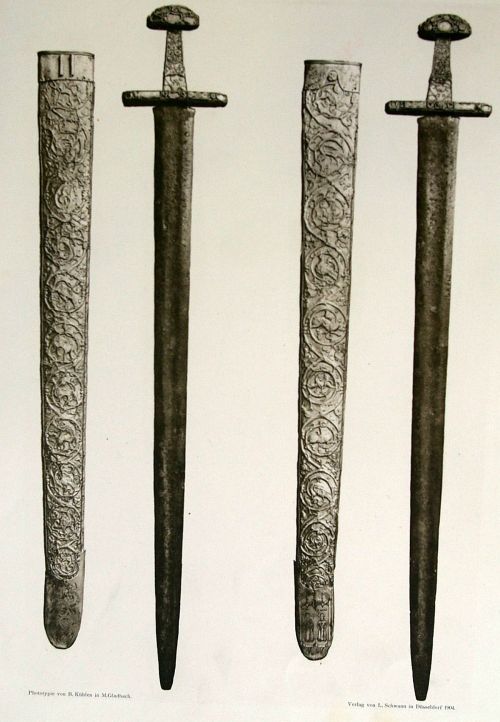art-of-swords:The Sword of Essen (Sword of Saints Cosmas and Damian)The Sword of Saints Cosmas and D
art-of-swords:The Sword of Essen (Sword of Saints Cosmas and Damian)The Sword of Saints Cosmas and Damian, also known as the Sword of Essen, is a ceremonial weapon in Essen Abbey. It was a gift from Otto III, Holy Roman Emperor to the convent in Essen in 993 A.D. and symbolises the martyrdom of Saints Cosmas and Damian, the patron saints of that city.The blade is 93.6 cm long. It features gold filigree though not much of this remains, along with precious stones and decorative enamel plates. The scabbard is lined with beechwood and covered in embossed gold plates, some of which have at some time been restored, that depict spirals, foliage and animals. The locket mounts show images of Saints Cosmas and Damian, along with the Latin inscription: “GLADIVS, CVM QVO DECOLLATI FVERVNT NOSTRI PATRONI” meaning “The sword, with which our patrons were beheaded.”Perhaps the finest and possibly the earliest of the historical swords that the hand of Time has spared us is the superb but little-known sword in the Dömschatz at Essen, Germany. Probably this is the only sword that can possibly claim the antiquity assigned to it, namely, the Xth or XIth century, as apart from its actual form the argument of its decoration vigorously acclaims its very early date. The metallography made on this sword, an analysis undertaken by emission spectroscopy on the surface of the blade, shows that the sword is indeed 10th/11th century.The designs on the sword show Byzantine influence, such as is in the designs of foliage and animals conjoined with the leaves on this scabbard. There is the possibility that it was made in Constantinople, and either looted from there or sent as a present by the Empress Theophano to one of the German emperors, afterwards to be presented by them to the Abbess of Essen. There is given more space to the consideration of these facts for the Essen sword than to the other weapons of this time, partly because this weapons is appreciated as the most important of its period extant, and certainly the most complete in all its parts.Indeed, the question has arisen, a question not lightly to be set aside, as to whether or no the blade is not of even greater antiquity than is claimed by the mounting. There is the possibility, and tradition so claims it, that the blade belongs to Roman times, to the 4th century, and was used at the execution of the patron saints of Essen, St. Kosmas and St. Damian, who suffered for their Christian faith in the year 303 A.D.. Though within the category of truth, this tradition requires strong belief.Due to constant reconstruction and work, today the sword is about 94 cm long. The guard has a length of 14 cm. The width of the blade to the blade guard is 5.5 cm, in the middle of the blade 4,5 cm. Approximately 10 cm from the blade tip is removed. The length of the scabbard is 82 cm, the mouthpiece 7.5 cm, 6.5 cm in the middle and at the chape is .5 cm wide. The blade weighs 823.8 g, 238.7 g (the pommel) and the guard 254.5 g.Sources:“The Sword and the Crucible: A History of the Metallurgy of European Swords” By Alan Williams“A record of European armour and arms through seven centuries: Chapter I Part 2 - Swords” by Laking, Guy Francis“Das Zeremonialschwert der Essener Domschatzkammer” - Aschendorff, Münster 1995 by Alfred PothmannOh, wow. -- source link
#sword#swordporn



